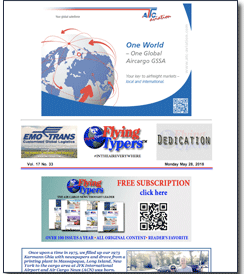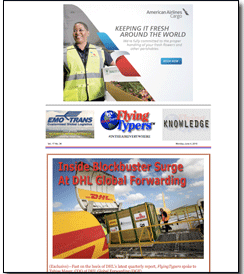
So far, the much-anticipated
surge in rates on healthy global economic growth and tight capacity has
not materialized on the major East-West lanes.
Freightos put it mostly bluntly in declaring:
“No News Is The News For Air Freight Rates.”
The digital marketplace reported in early
June that average air freight rates “haven’t moved since late
March,” rating them in the range of $2.90-$5.00 per kg on the China-U.S.
lane, $2.80-$4.50 on China-Europe, and $1.80-$2.70 for Europe-U.S.
Flexport reported a similar picture earlier
this month with no space constraints evident and rates stable ex-China,
ex-Hong Kong, ex-Vietnam, and ex-Europe.
Ex-U.S., Frieghtos said rates remained high
for Latin America, where industrial action and a lack of fuel in Brazil
saw flights cancelled in late May, but were stable elsewhere.
“Space has opened up slightly for
exports to Europe and Asia due to the additional seasonal summer flights,”
it added. “Space is tighter on certain lanes to the Middle East
and India, and space is very tight to Latin America.”
However, while in the last few months markets
have been stable, TAC Index’s specific lane pricing analysis reveals
in more detail how rates have risen since last year.
For example, on June 12, 2017, rates on
the Hong Kong-North America lane were $3.24 per kg, but by June 11 this
year they were up to $3.77 per kg, having peaked in between at $5.57 during
December. Hong Kong-Europe rates over the same period showed a similar
pattern (albeit prices were significantly cheaper than on the Transpacific),
rising from $2.26 per kg on June 12, 2017, to $2.71 per kg on June 11,
2018, having reached the (relatively) giddy heights of $3.29 in the December
peak season.
Volumes, like rates, are also growing year-on-year.
WorldACD’s latest analysis removed distortions related to factory
shutdowns during Chinese New Year by shining a light on the first quarter.
It found that over the first three months of 2018, volumes were up 4.8
percent year-on-year globally and rose a further 4 percent in April, illustrating
what it called “serious business growth in air cargo.”
WorldACD said that so far in 2018, some
key trends had emerged.
For example, pharmaceutical products and
high-tech shipments are up 17 percent and 11 percent respectively, year-on-year.
The analyst also noted that volume growth
in the first quarter was highly variable by region and trade lane. So
far in 2018, the Asia Pacific, the largest origin area, has been growing
at only 3.7 percent year-on-year, with volumes up 4.8 percent to Europe
but only 2.1 percent to North America. But
from Europe, the second largest origin area, growth is mainly to North
America, up 4.6 percent year-on-year, rather than to the Asia Pacific,
up 1.4 percent.
While from North America, the third largest
origin area, exports are up by 8 percent year-on-year thanks to strong
demand from both Asia and Europe.
“With the exception of growing transatlantic
business from Europe, could it be that all these trends are nicely in
line with economic theory?” said the analyst.
“After all, the USD has been relatively
cheap in this period and the Euro relatively expensive. One would thus
expect North America to export more, and Europe to import more.
“With the surge of the USD since early
May, we may well be able to already ‘test’ this position in
one month’s time, when the May results will be in.”
 Looking ahead, IATA argued that relatively
becalmed markets were mostly down to the time of restocking cycles and
consistent with demand drivers moving away from the highly supportive
levels seen last year; for example, the Purchasing Managers’ Index
for manufacturing and export orders fell in April 2018 to its lowest level
since 2016. Looking ahead, IATA argued that relatively
becalmed markets were mostly down to the time of restocking cycles and
consistent with demand drivers moving away from the highly supportive
levels seen last year; for example, the Purchasing Managers’ Index
for manufacturing and export orders fell in April 2018 to its lowest level
since 2016.
IATA's Director General and CEO Alexandre
de Juniac said he expects markets to pick up later in the year, but warned
there were also risks to growth, not least, he implied, from U.S. trade
policy under President Donald Trump.
“We remain cautiously optimistic that
demand will grow in the region of 4 percent this year,” he said.
“But the forecast appears to have increasing downside potential.
“Oil prices continue to rise as does
protectionist rhetoric. Borders open to people and to trade drive economic
growth and social prosperity.
“We are all disadvantaged when they
are closed.”
SkyKing |




 Vol.
17 No. 33
Vol.
17 No. 33 Vol.
17 No. 34
Vol.
17 No. 34